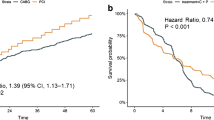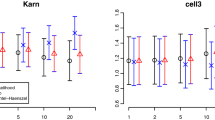Abstract
We study regression models for mean value parameters in survival analysis based on pseudo-observations. Such parameters include the survival probability and the cumulative incidence in a single point as well as the restricted mean life time and the cause-specific number of years lost. Goodness of fit techniques for such models based on cumulative sums of pseudo-residuals are derived including asymptotic results and Monte Carlo simulations. Practical examples from liver cirrhosis and bone marrow transplantation are also provided.



Similar content being viewed by others
References
Aalen OO (1989) A linear regression model for the analysis of life times. Stat Med 8:907–925
Andersen PK (2013) Decomposition of number of years lost according to causes of death. Stat Med 32:5278–5285
Andersen PK, Perme MP (2010) Pseudo-observations in survival analysis. Stat Methods Med Res 19:71–99
Andersen PK, Skovgaard LT (2010) Regression with linear predictors. Springer, New York
Andersen PK, Klein JP, Rosthøj S (2003) Generalized linear models for correlated pseudo-observations, with applications to multi-state models. Biometrika 90:15–27
Andersen PK, Hansen MG, Klein JP (2004) Regression analysis of restricted mean survival time based on pseudo-observations. Lifetime Data Anal 10:335–350
Cox DR (1972) Regression models and life-tables. J Roy Stat Soc B 34:187–220
Eddelbuettel D, Francois R (2011) Rcpp: seamless R and C++ integration. J Stat Softw 40(8):1–18
Graw F, Gerds TA, Schumacher M (2009) On pseudo-values for regression analysis in competing risks models. Lifetime Data Anal 15:241–255
Højsgaard S, Halekoh U, Yan J (2005) The R package geepack for generalized estimating equations. J Stat Softw 15(1):1–11
Jacobsen M, Martinussen T (2016) A note on the large sample properties of estimators based on generalized linear models for correlated pseudo-observations. Scand J Stat 43:845–862
Klein JP, Andersen PK (2005) Regression modeling of competing risks data based on pseudovalues of the cumulative incidence function. Biometrics 61:223–229
Klein JP, Gerster M, Andersen PK, Tarima S, Perme MP (2008) SAS and R functions to compute pseudo-values for censored data regression. Comput Methods Programs Biomed 89:289–300
Li J, Scheike TH, Zhang MJ (2015) Checking fine and gray subdistribution hazards model with cumulative sums of residuals. Lifetime Data Anal 21(2):197–217
Lin DY, Ying Z (1994) Semiparametric analysis of the additive risk model. Biometrika 81:61–71
Lin DY, Wei LJ, Ying Z (1993) Checking the Cox model with cumulative sums of martingale-based residuals. Biometrika 80:557–572
Lin DY, Wei LJ, Ying Z (2002) Model-checking techniques based on cumulative residuals. Biometrics 58:1–12
Lombard M, Portmann B, Neuberger J, Williams R, Tygstrup N, Ranek L, Larsen HR, Rodes J, Navasa M, Trepo C, Pape G, Schou G, Badsberg JH, Andersen PK (1993) Cyclosporin A treatment in primary biliary cirrhosis. Results of a long-term placebo controlled trial. Gastroenterology 104:519–526
Martinussen T, Scheike TH (2006) Dynamic regression models for survival data. Springer, New York
McDaniel LS, Henderson NC, Rathouz PJ (2013) Fast pure R implementation of GEE: application of the matrix package. R J 5:181–187
Overgaard M, Parner ET, Pedersen J (2017) Asymptotic theory of generalized estimating equations based on Jack-knife pseudo-observations. Ann Stat 45(5):1988–2015
Perme MP, Andersen PK (2008) Checking hazard regression models using pseudo-observations. Stat Med 27:5309–5328
Scheike TH, Zhang MJ (2002) An additive-multiplicative Cox–Aalen model. Scand J Stat 28:75–88
van der Vaart A (1998) Asymptotic statistics. Cambridge University Press, Cambridge
Author information
Authors and Affiliations
Corresponding author
Additional information
Corresponding author has been updated to Dr. Per Kragh Andersen.
Klemen Pavlič—Deceased.
The work on this manuscript was conducted, primarily by the first author Dr. Klemen Pavlič, while he visited University of Copenhagen, Section of Biostatistics, in the spring of 2017. After the final acceptance of the manuscript, Dr. Pavlič sadly died in an accident in June 2018.
Electronic supplementary material
Below is the link to the electronic supplementary material.
Rights and permissions
About this article
Cite this article
Pavlič, K., Martinussen, T. & Andersen, P.K. Goodness of fit tests for estimating equations based on pseudo-observations. Lifetime Data Anal 25, 189–205 (2019). https://doi.org/10.1007/s10985-018-9427-6
Received:
Accepted:
Published:
Issue Date:
DOI: https://doi.org/10.1007/s10985-018-9427-6




